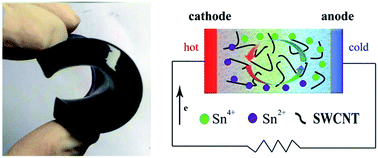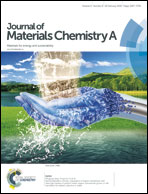Flexible gel-state thermoelectrochemical materials with excellent mechanical and thermoelectric performances based on incorporating Sn2+/Sn4+ electrolyte into polymer/carbon nanotube composites†
Abstract
Thermoelectrochemical (TEC) materials are newly developed energy materials, which are promising and cost-effective in harvesting waste thermal energy based on redox electrolytes. However, liquid-state electrolytes and low thermoelectric (TE) performance seriously limit their application. Here, we report the first gel-state TEC (gel-TEC) materials based on incorporating Sn2+/Sn4+ electrolytes into polymer/single-wall carbon nanotube (SWCNT) composites. A porous 3D network morphology is observed, and the effect of SWCNT content on the tensile mechanical properties and TE performance is studied. Due to their large Seebeck coefficients and significantly enhanced electrical conductivities (10.5 ± 0.8 S m−1), the power factor at room temperature can reach 13.5 ± 3.0 μW m−1 K−2, greater than those of liquid-state TEC materials and possibly the highest for gel-TEC materials. The gel-state, outstanding mechanical properties and excellent TE performance of the gel-TEC materials will speed up and widen their application in various fields such as flexible devices, wearable electronics, e-skins, etc.



 Please wait while we load your content...
Please wait while we load your content...